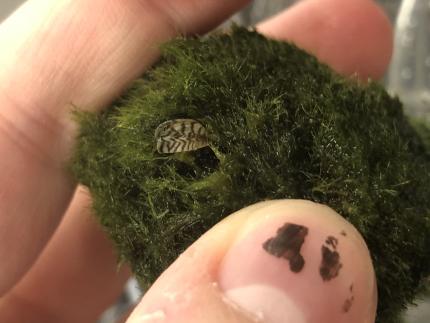The Washington Department of Fish and Wildlife (WDFW) is asking anyone who has purchased moss balls for their aquarium in the past year to inspect the plants for invasive zebra mussels.

On August 5th, WDFW received notification from a local wholesale aquarium company in King County of invasive mussels on a shipment of moss balls. WDFW rapidly responded and is leading testing, response coordination, and the proper disposal protocols of contaminated products. WDFW is working alongside industry, tribal, state, and federal partners on this incident, and wish to thank and highlight all partners working together to keep Washington’s waters free from invasive species.
In March 2021, several states reported the presence of both live and dead zebra mussels at pet store retailers nationwide. Retailers quickly acted to pull the product from shelves and place them in quarantine. The wholesale distributors out of California and Florida were notified, and shipments into the country were ceased. March 4, 2021 news release.
Zebra mussels are a prohibited aquatic invasive species in Washington State that, if established in local waters, would be capable of causing significant infrastructure and environmental damage.
Quagga and zebra mussels can clog pipes and mechanical systems of industrial plants, utilities, locks, and dams. If invasive mussels take hold in Washington, officials estimate it would cost more than $100 million each year to keep Washington’s power and water infrastructure running, in addition to causing catastrophic ecological damage.
How to report
WDFW and the Washington Invasive Species Council recommends that anyone who thinks their aquarium may be carrying invasive mussels to report it online using the Washington Invasives app or online reporting form. It is as easy as taking a photo and submitting for an expert to review.
How to safely dispose of moss balls
Methods for the aquarium owner to safely dispose of the moss ball(s):
- Place the moss ball (s) into a sealable plastic bag and freeze for at least 24 hours. After that, the moss ball(s) can be disposed of in the trash.
- Place moss ball(s) in boiling water for at least one full minute. After that, the moss ball(s) can be disposed of in the trash.
Decontaminate the aquarium, accessories, and water:
If the moss ball was placed in an aquarium, please take these additional steps to decontaminate your aquarium and accessories. For additional guidance on holding fish during treatment or re-establishing your aquarium following treatment, contact your local retailer.
If the moss ball was placed in a water garden, or fish or plants cannot be removed from the aquarium for treatment, please refer to the Potassium Chloride (KCl) Method below.
- Collect any fish or other living organisms and place them in another container, with water from a separate, uncontaminated water source.
- Remove water from aquarium and sterilize by adding 1/3 cup of bleach per gallon of water. Let the water sit for at least 10 minutes and then dispose the sterilized water down a household drain.
- Decontaminate the aquarium and accessories using one of the following methods, in accordance with manufacturers’ recommendations:
Hot Water Method:
- Pour water that is 120 °F into aquarium, covering all accessories.
- Allow to sit for a minimum of 5 minutes, ensuring that the water temperature is maintained.
- Allow the water to cool, then dispose of treated water in a household drain.
Saltwater Method:
- Use a saline solution of 1/2 cup of salt (NaCL) per gallon of water.
- Soak aquarium, substrate, rocks, décor, and filter media in saltwater solution for at least 24 hours.
- Dispose of treated water in a household drain.
- Rinse off all items prior to re-setting up the aquarium.
Bleach Disinfection Method:
- Use a disinfection solution of 1/3 cup of bleach per gallon of water.
- Soak aquarium, substrate, rocks, décor, and filter media in the bleach water solution for at least 10 minutes.
- Dispose of treated water in a household drain.
- Rinse off all items prior to re-setting up aquarium.
Allow aquarium and accessories to dry for at least 15 minutes before refilling with water.
It is recommended that you perform a standard water change (~20%) within a week and continue to monitor the aquarium for any unusual or unexpected aquatic life. If needed, repeat steps 1 - 5.
Aquarium species and accessories:
Collect the fish & plants and place them in another container. Dispose of the water in a sink or toilet. All municipal wastewater is treated to kill all pathogens, and septic tanks are fully self-contained underground.
Carefully use water that is 140 degrees to flush and coat all the tank and accessory surfaces. It is recommended that you do another water change within a week and continue to monitor the tank for any unusual aquatic growth.
If you do not have access to high temperature water, a 1/3 cup of unscented household bleach per gallon of water can be used as a disinfectant. Allow the aquarium, substrate, rocks, décor, and filter media to soak in the bleach water solution for 10-15 minutes. After adequate contact time, thoroughly rinse off all items prior to resetting up the aquarium. When resetting up the aquarium, dispose of the previously used filter media and replace with new media. Finish by using a dechlorinating product to neutralize any residual chlorine prior to reintroducing aquatic life.
For extremely large aquariums that you may not be able to completely dewater/decontaminate, dispose of the moss ball(s) as above. Officials recommend that the public conduct frequent water changes and continue to monitor the tank for any unusual aquatic growth.